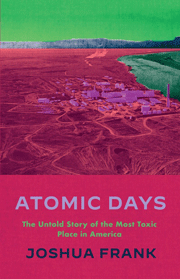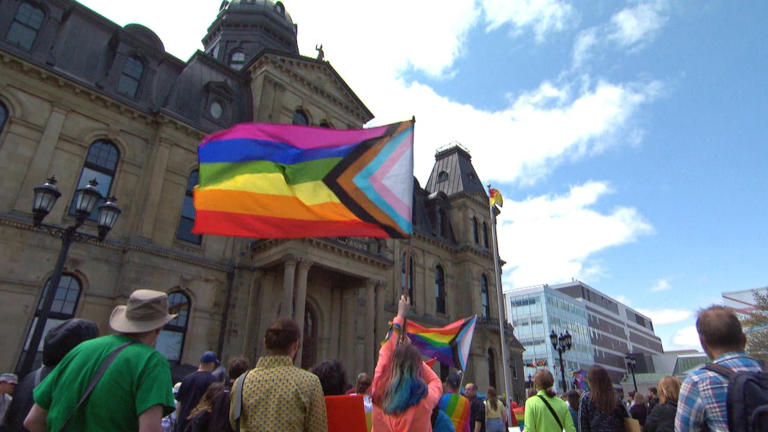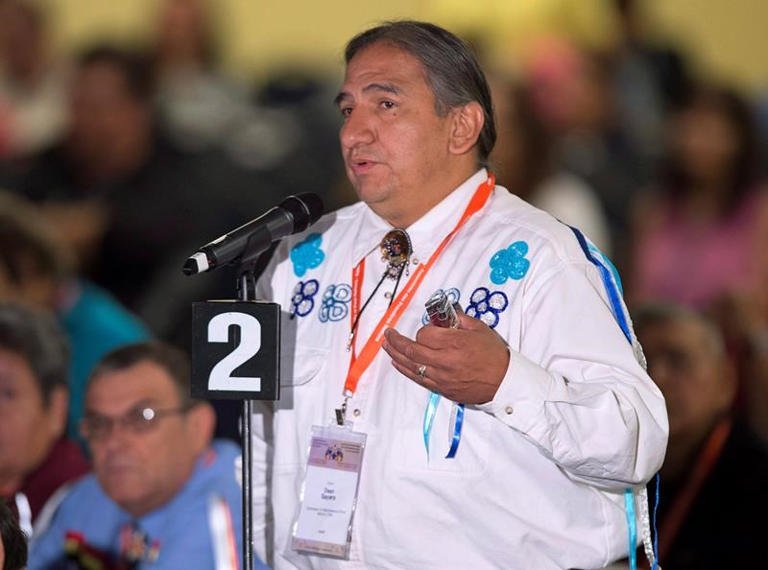Why the Left Must Oppose Nuclear Power
LONG READ
Scott Parkin: Welcome to the Silky Smooth Sounds of the Green and Red podcast. I’m your co-host Scott Parkin in San Francisco, California today, and I’m joined by…
Bob Buzzanco: Bob Buzzanco in Niles, Ohio.
Scott: There’s been a, a bit of a conversation going on in the mainstream and left media that we’re talking about today, which is around nuclear energy, nuclear power, nuclear weapons.
The Green and Red Podcast is very decidedly anti-nuke, or no nukes, and we’re more than a little bothered about the of pro-nukes position that we’re hearing from other people who call themselves “leftists” and “socialists” and the like. So joining us today to talk about all of this and his book Atomic Days is Joshua Frank.
Welcome back to Green and Red, Josh.
Joshua Frank: Thanks for having me. Good to be here.
Scott: Josh is the managing editor of CounterPunch and he is the author of Atomic Days, the Untold Story of The Most Toxic Place in America. And maybe we could talk a little bit about that. The book talks a lot about the nuclear weapons production facility in Eastern Washington, in Hanford, Washington.
And, you know, just to kind of play off the title, Josh, why is it an untold story?
Joshua: Well, you know, the book has a lot of information in there that I don’t think is publicly available or wasn’t until we published the book. But more, it’s really just a kind of the peoples’ story of Hanford and of the weapons production site.
Maybe some of your listeners don’t know about Hanford was one of the three locations chosen during the Manhattan project and their job was to produce plutonium. The first commercial plutonium reactor was built in Hanford, the B reactor. The site produced plutonium for the first bomb that was dropped on Nagasaki.
And over the course of about four decades, it produced the majority of the plutonium that ended up in the atomic arsenal of the United States. But in, and that was mostly during the Cold War, at the end of the Cold War. It became a cleanup site almost overnight in the late 80s.
So a little bit about Hanford. Hanford’s in eastern Washington. It’s located along the Columbia River. It was chosen as a location because it was remote, it was sort of “out of sight, out of mind.” The Indigenous communities that were there and also some of the poor farm communities were easily removed. And it’s a very expansive area. It’s almost 600 square miles and it’s beautiful terrain, but it’s terrain that will never, in our lifetimes, unfortunately, be publicly accessible because it’s so toxic.
So when it was producing plutonium over the course of its lifetime, it also produced a ton of waste chemical waste, and obviously high-level radioactive waste. That much of that waste, the high-level radioactive waste in particular, is still out there. It’s sitting in these huge hulking underground tanks, 177 of them.
149 of those tanks are single-shelled tanks, and they still hold 56 million gallons of radioactive sludge. The problem, of course, is what to do with this stuff as we’ll talk about nuclear energy. It’s kind of the same problem with plutonium and other byproducts of the process of fission. But in the case of Hanford, we’re dealing with the aftermath of the U.S. war machine.
I like to say that the Cold War in many ways, it’s still bubbling out there. And these tanks, just to kind of talk about how perilous it is, the tanks really were only supposed to last a couple of decades. I mean, we’re going on a long time now. A lot of them were built in the 50s and 60s.
They’re only supposed to last until the early 80s at most. And, which I talk about a lot in the book. I mean, even early on, engineers were talking about that this is really a temporary solution for this problem that they did not have a long-term answer for. And of course, they don’t have a long-term answer to store nuclear waste anywhere.
But especially then, but of course, the quest to prop up the U.S. war machine and an atomic arsenal took precedence and was far more important than worrying about the aftermath. And so that waste out there is really in a bad situation. Two of the tanks right now are leaking into the groundwater supplies underneath them.
These tanks are six, seven miles from the Columbia River, so that groundwater will eventually reach the Columbia River, in many cases it already has. There were documented at least 67 leaks over the course, of Hanford’s lifetime. And then we had intentional releases of radiation.
We’ve had other accidents. I mean, it’s a horrible, horrible situation. And it is now the costliest environmental cleanup in world history. The price tag is at $677 billion right now. To put that in perspective, it was $450 billion, just a couple of years ago. So my guess is by the end of the decade it’ll be over a trillion dollars.
And not really any major work has been done. None of that high-level radioactive waste has been vitrified, which is what they’re planning on doing. And vitrification is really just like taking the stuff out of these tanks and turning it into glass so that it can be stored safely, or you know, as safely as it can be.
So it’s a really, really bad situation. And those two tanks that are leaking right now, the Department of Energy, which oversees the project, doesn’t have an answer for because there isn’t really good answers for this stuff, which is a huge problem. So the book really gets into all of this. It gets into the whistleblowers that are calling out the contractors and calling out the Department of Energy and also talking about the worst-case scenarios.
The leaking tanks are obviously a huge immediate problem. These tanks are producing hydrogen and they have to be continually off-gassed. Because if there’s a hydrogen buildup in one of these tanks and somehow there’s a spark that ignites it, or electricity goes down or something malfunctions, there’s a number of scenarios or could be an attack of some sort.
Several scenarios could lead to literally an atomic explosion. I mean, you have a hydrogen buildup in one of these tanks that explodes, and that radioactive material could spread far and wide. And not a lot of people know about this place. Even though we’re paying for it, a lot of people in the Northwest don’t really know what’s going on there.
So my hope is that that story that hasn’t really been told makes its way out with this book.
Scott: The efforts to clean it up are mostly actually being outsourced, correct? Right. Like there’s, there’s a lot of like Bechtel and, and others. I’m going to assume that’s part of the exorbitant cost.
Joshua: Yeah, absolutely. Bechtel really came up with this idea that’s now really central to all of the defense contracts and Department of Energy contracts called “cost-plus contracts.” And essentially, that is an open checkbook that the government has or that they have with the government.
You can kind of think about it if you’re remodeling your kitchen and the contractor gives you an estimate for $15,000, but it ends up being $25,000, well multiply that by billions and that’s essentially what has happened out at Hanford. The original estimates were reasonable compared to what they are now, and they really are getting paid to not get the job done in many cases.
And, and one whistleblower, Walter Tamosaitis, ended up being fired and sued and won [his lawsuit], and I wrote about his case about 10 years ago for Seattle Weekly. And he’s the central whistleblower calling Bechtel out and also the Department of Energy out for being complicit in this. And even more so on the technical side, the contractors kind of run the show out there.
The Department of Energy is just really understaffed. They don’t have the technical expertise to oversee every aspect of the cleanup. Because the Department of Energy’s underfunded, the money is being shelled out to the contractors but not to the Department of Energy. And the Department of Energy, much like the EPA and other agencies, especially under the Trump administration, were defunded.
It’s just making matters even worse.
Scott: And they put Rick Perry in charge of it. Which says a whole lot.
Joshua: Yeah, yeah, exactly. One scientist that I interviewed who goes on record is Donald Alexander who also I would consider a major whistleblower, at least from the Department of Energy side of things, talks about this.
He talks about how his staff, he’s now retired, but his staff really just didn’t have enough people to oversee all these aspects of the project. So, a lot of times, problems that arise could have been solved sooner, but they just didn’t have the mechanisms in place to catch it.
And it’s a problem that permeates the cleanup out there. And I think it’s important also to … I get this question a lot what does a “cleanup” look like? I mean, there are, aside from all that radioactive waste in those tanks, there are hundreds of billions of gallons of chemical waste that was literally dumped into the soil out there, during its process when it was making plutonium.
So, how do we remediate that? What does that look like? And I don’t think it’ll ever be cleaned up in the sense that it’s ever going to be what it once was, unfortunately. But cleanup to me means getting this to a place where we aren’t on the verge of a major radioactive accident. And right now, we are on the brink of that.
And every day that goes by it, it becomes greater.
Scott: Just thinking about the Columbia River, Portland is downstream from the Columbia River. This stuff leaks into the Columbia River then it’s a major metropolitan area that’s facing radioactive poisoning.
Joshua:. Yeah. And, and aside from that, I mean the, Columbia River there’s commercial fisheries.
The Columbia feeds tens of thousands of Northwest farmers. A major accident out there, aside from the slow leaking process that would build up over time … if we did have a major accident out there, the economy of the Northwest would just crumble.
And if this stuff were to go airborne, all bets are off. I think it could spread to the East Coast. Of course, just like when we have big fires in Northwest, there was smoke that covered Washington D.C. The radioactive particles would spread far and wide.
I think cities like Boise, Idaho, that are closer might become unlivable. The radioactive fallout could be so great. People don’t want to live there. I mean, it could be really devastating. And, of course, if there was an economic collapse in the Northwest, that would trigger a global economic crisis.
Not, and that’s just the economic side, right? I mean the environmental side and the toll on the environment and humans would be even greater. So yeah, it’s a scary situation.
Bob: I think, well, for a while now, especially since Three Mile Island, I think just the general public has been really concerned about nuclear power as well as nuclear weapons.
A big resistance to it, like “No Nukes,” but now it’s making a comeback. Even on the left or maybe especially on the left. And I just wonder why you think these folks like Jacobin and certain podcasts have gone all in. They’re portraying it as this kind of pro worker, anti-fossil fuel thing. But you know, I was raised in an era where no nukes was kind of a core value.
Joshua: Before I really get in, get into my sort of anger towards some of their positions, I do think that a lot of the younger generation on the left that haven’t been around long and don’t know a lot about the anti-nuke movement, they don’t understand the success of the anti-nuke movement of essentially putting the brakes on the proposals for hundreds of plants.
They don’t really understand Chernobyl, don’t understand Fukushima but are really, really frightened about climate change, rightfully so. And so, when the boosters of atomic energy come along and say, “oh, here’s an easy fix. This is a technology we’ve had forever,” and you believe the propaganda, right?
Which is that it, it’s safe, it’s reliable, it doesn’t produce CO2 emissions. All of these things are very attractive, I think, to some people that don’t hear the other side of it and the reality of atomic energy. I’d like to give some of them, at least, the benefit of the doubt that they haven’t been well informed.
But again, those people that are spewing propaganda are the ones that need to be challenged. And we all know who they are, and they are essentially mimicking the talking points that we’ve been hearing for decades. And they’re well-funded. And now using climate change as the scapegoat for pushing for “this is our future.”
I think we’re going to have to continue fighting. This propaganda that’s coming out of the pro-nuke left. And I think it’s very real. I think it’s dangerous and I think that, fortunately and unfortunately, if we see an accident at Zaporizhzhia. I mean, now in Ukraine, we’re learning that these nuke plants are tools of war and are forever going to be used as tools of war.
Putin set a very dangerous precedent there. What if there was an accident, an attack, if the backup generators fail? If several things happen, these conversations could change tomorrow. I mean, if you even believe all the rhetoric that we have an answer for the waste that uranium mining’s benign, they’re totally safe and reliable. No one, no one. Not even the biggest proponents of atomic energy are going to tell you that, these things are safe in a war zone. So, I mean there are just so many reasons to oppose this stuff.
Scott: Well, I have seen some of the propagandists actually saying that they are safe in a war zone.
Joshua: It’s momentary. They’ve said that the worst that can happen is that it can go offline. I think they are genuinely ignorant. Leigh Phillips said at one point to me that the worst that could happen at Zaporizhzhia was that the power could go offline. Yeah, I think there’s a lot more that could happen.
Scott: Back to the whistleblowers for a moment. some Indigenous activists have also been part of this sort of resistance to the lack of action on cleanup or whatever. Has there been any retaliation against some of the whistleblowers around Hanford?
Joshua: Oh yeah, yeah, big time. There’s been, you know when I was writing for Seattle Weekly and covering Hanford, there was a string of whistleblowers that each really faced different types of persecution.
Some of them in, in the case of Walter Tamosaitis, they silenced him by removing him from his post and then literally putting him in a basement office. And then he became an in-house consultant he would travel around the different sites. He worked for a contractor under Bechtel, a subcontract for Bechtel, and just ruined his life and ruined his career.
And he was just one example. Others were similarly silenced and reprimanded for speaking out. The DOE has gone after Bechtel for some of these things. They’ve paid fines. They’ve lost lawsuits and many times, you know, they do these payouts. They never have to admit guilt.
But the culture out there is very much the same. It’s still very secretive. And there’s just so much profit at stake. So these whistleblowers are a threat to that profit margin. And sometimes, getting the job done and meeting the deadlines on time is a disincentive because they don’t reach their benchmarks and get those extra payouts.
So the way these contracts are structured lend to an environment that is harsh towards whistleblowers, and that’s just sort of at the contractor level. The bigger level is, because the site operated like a covert military site for so long. That sort of secrecy around the whole cleanup still exists, and the government is good at, at keeping people in line, and they are constantly around managers and it’s really hard to get a grasp of what’s going on out there.
And that’s on purpose. So when you have some of these guys that are old-time engineers and scientists speaking out. We must listen to them. And they’re not always, you know, they’re not always progressives, these are mostly like conservative Republicans that are worried about taxpayer dollars and some of the things that we can agree on, you know?
And they’re also very worried about the safety at Hanford as well, and the risks that it poses. So, that’s the job of journalists, right? And others too, to try to get their stories out to the world because they certainly don’t make it easy to do.
Bob: Moving into this, this current resurgence in this, these, you know, kind of pro-nuclear arguments, it seems like what a lot of these people are saying, is this cleaner, it’s safe or it’s less expensive, and, and just wondered if you want to kind of give a, a brief description of what they’re saying and then we can kind of get into the larger issue of talking about what the reality is.
Joshua: Sure. Maybe I’ll put myself in their shoes for a second. Well, I think they focus on the CO2. Right? And I think that they downplay the risks that the waste poses as well. So what they’ll say is, “Look, we can it’s going to take tens of thousands of square miles of open space to put in solar panels.”
We could put a small plant. They call them SMRs now. Small modular reactors are all over the place and power everything endlessly. Wind power, solar power, that is really great when the wind’s blowing and the sun’s shining bit. What about at night? We need to have something that’s continuous.
And so we need something that compliments other renewable energies. And, nuclear is perfect for that. It’s also really safe. The accidents that have happened are really overblown. Chernobyl really didn’t kill as many people as they say Fukushima was avoidable. Not that big of a deal.
Three Mile Island didn’t hurt anybody. So, the accidents themselves are completely overrated, and it’s a lot of fear-mongering going on. Uranium mining, “yeah, it was really dirty and bad in the past and had some problems, but we can do it in a much better fashion, and mining for minerals that go into solar panels and wind turbines and everything else is also very impactful.”
Lithium mining has horrible effects too. So, we can’t ignore uranium mining. We should look at this whole picture here.
Scott: Jobs. Jobs, lots of jobs.
Joshua: Jobs, yeah. That’s right. And it’s jobs. Jobs for our plants are good, well-paying jobs.
Right. So yeah, I think those are a lot of the things that I hear consistently. And of course, this is, it’s a carbon-neutral energy source. There’s nothing better than that, right? So that’s, that’s, that’s the rhetoric that I hear a lot. Which, of course, can be debunked pretty easily. Uranium mining is, is horrible.
And, you know, I guess first to say that those of us that oppose nuclear energy don’t also see some of the negative impacts of renewables is ridiculous, right? I mean, of course we know that lithium mining can be horrendous, and we know all of these things and we probably are, hopefully, promoting de-growth and not just switching to other sources of energy.
And we understand the underpinnings of capitalism and how that plays into all of this and, of consumption, right? So to just think that like, oh, these people just because you well, some of them are even more disingenuous, some of them will say, oh, you oppose atomic energy. That must mean you’re, you want coal energy everywhere. That kind of thing. And they’ll even go so far as they say that the anti-nuke movement was responsible for coal being as dominant as it is, which of course, is bullshit. Coal is dominant because it’s cheap. I mean, India was, and China continued to build coal plants because it’s really, really cheap, and it’s plentiful.
That’s why it’s happening, not because of the anti-nuke movement. But aside from that, when it comes to the climate change issue, there are a number of things that I think they are blatantly misrepresenting and ignoring. One is that it’s so much more expensive to promote atomic energy than it is to go and promote renewables.
Also, the timeframe for this stuff, if you believe the latest, like IPCC reports, we’ve gotta reduce by 2030 something like, I don’t even know what is it, 50% CO2 emissions. We can’t roll out nuke plants in time to meet those goals. It just isn’t feasible. And then, aside from that, it’s not reliable.
This is not a reliable energy source. I often look at France which they sort of put up on the pedestal as the perfect atomic nation in the world that it operates perfectly and everything’s great there. Well, that’s not true at all. Last summer, during the height of the European heatwave, half the plants in France were offline.
And they were offline because of corrosion issues, but a lot of them were offline because the rivers that they draw water from to cool down the reactors were too warm in some cases, too low to cool reactors down. So you have climate change, which is evaporating the rivers and making them too warm to cool down the reactors in the first place, so it’s not reliable.
And then, of course, the risks. And what the risks, and then of course, the waste. There’s no answer for the waste. None of them have an answer for permanently storing this waste safely for millennia. I don’t think a lot of people understand the dangers of plutonium and which I’ve learned a lot about in researching Hanford.
But this stuff sticks around. It’s radioactive for 250,000 years, so really, to keep it safely stored and if we had as many new plants as they want, thousands of them all over the world, we’re going to have so much plutonium. You’re going to have this stuff’s be around way after we’re gone, right?
And how are you going to keep that safe? How are you going to, even the ideas of putting it in tombs and storing it deep underground, what’s that going to look like in a hundred thousand years, you know, let alone 250,000 years. And then, on top of that, this stuff can be used in bombs. Once plutonium goes through the fission process, or uranium goes through the fission process, produces plutonium, you’re already one step closer to being able to use that in an atomic warhead. So proliferation is a huge, huge issue. And for anybody on the left that doesn’t see the connection between atomic energy and atomic bombs is completely ignorant or completely disingenuous financially.
They’re linked. They’re linked in France, they’re linked to the US, and they always will be. And then they’re, they’re linked scientifically. I mean, you can’t have one without the other. And the governments are always going to be in charge of this stuff because of the risk of proliferation. So you can’t separate those two issues, and there’s no other energy source that, poses these kind of problems.
And I, you know, I challenge anybody that’s proponent of this that also wants to de-escalate. It’s a threat of nuclear annihilation to address these issues and I haven’t seen anybody do it very well.
Bob: What’s striking is in the last few months we’ve had all these train derailments. And you know, what’s kind of proved the government does nothing to inspect these things and doesn’t have a solution to it.
In Texas, where I spend a lot of time, people froze to death, you know, during, during a cold snap. Why is there this sense that somehow nuclear energy is going to be regulated or made safe by the same people who can’t keep a railroad on the tracks?
Joshua: Yeah, and this isn’t to say, think about that waste when they’re transporting it.
Bob: I think one, wasn’t one of the derailments going to pick up nuclear waste?
Joshua: Yeah, one of them was right. Yeah. And this actually going back to Hanford back in the 80s and some of the Indigenous struggles there. Hanford at that time, along with Yucca, was being eyed as a depository repository for waste, high-level waste.
And the Yakima Nation led by Russell Jim, who I have a chapter about in the book, fought back against this. They said basically, “Hanford is toxic enough. We don’t need to shovel more radioactive waste into Hanford.” And part of that was also they were fighting railroads and transportation routes through Yakima Nation to Hanford.
And they knew back in the 80s; you can’t just put it on the truck and haul it around and think that it’s no, no risk of an accident. It’s a huge issue and they were able, they were successful and they blocked Hanford from receiving more waste. And, over that, during that fight the public was given tens of thousands of previously secret documents and we learned a lot about what had been going on at Hanford. But anyway, fast forwarding to the transportation of waste, I mean, that’s another issue. And there’s think if we had hundreds and hundreds of these plants that were all, even if they somehow approved Yucca Mountain and you have all these railroads and all these routes going in to, to Yucca, even if we believed that the storage would be safe, which it never would be.
All that transportation poses its own risks. I mean, there are just so many problems around all of these issues around this technology that it’s like a no-brainer. I feel like for those of us that are concerned about the future of the planet, if it somehow was even carbon neutral, which of uranium mining is not carbon neutral? It’s very carbon intensive, but let’s say that it was, let’s say that everything’s carbon neutral. You still have all these other problems. And if the concern is about the future health of the planet, how can you ignore the rest of this stuff? I just find it mind-boggling.
Scott: There’s the amount of time that it would take. We have a timeline around climate urgency. 20 years, 50 years, what have you. And so, a return to nuclear energy in the U.S. You’re not going to be able to meet those timelines. But then also there’s the cost. My understanding is that Wall Street doesn’t actually have any interest in funding it.
No. The nuclear buildout, a new nuclear buildout doesn’t seem like the government wants to do it. And then I’m not quite sure if international financial institutions like the World Bank want to make loans to do that anywhere. It’s probably not in the US And so I’m kind of curious where they also think this is going to be funded from.
Joshua: Yeah. Well, I mean, they always point to the funding going into renewables and that there are subsidies for that and tax breaks. They look at Biden’s last big bill, the Inflation Reduction Act, which was $480 billion to renewables, but tucked into that is the ability to keep existing nuke plants open.
I don’t know what their answer is for that. Ultimately, I think that they don’t care about the price tag, and I think that they think that this is worth every penny that’s poured into it, and they don’t see it taking away from existing renewables. They see it as complimenting that which, of course it’s not.
It’s totally taking away from other things that we could be doing. But I think it’s also having this discussion about one versus the other, at least on the left. And from an environmental perspective. In my view, it takes away from some of the bigger, probably even more challenging conversations that we need to be having about our lifestyle and our society in general, and our consumptive nature and how we should be thinking about restructuring our cities, restructuring our transportation the way we grow food and how we travel.
You know, all of these things need to be part of the conversation and not just how do we switch from coal to nuclear or natural gas to solar. I mean, I think that there’s a bigger conversation that needs to go on, and I think it’s our duty on the left and as environmentalists to talk about this.
And I don’t think that they want to address that. I mean, a lot of these so-called leftists that are pro-nukers have no problem with it. They are pro-growth. They’re pro-consumption. They’re not that different, ultimately from the capitalist class, and I think that needs to be challenged as well.
Bob: Pro-air conditioning and all this other kind of stuff. Right. I guess that’s, that’s one thing that’s been striking because I’ve talked to MSNBC liberals who are pro. But also plenty of people I know who are like DSA folks who have jumped on the bandwagon and as you pointed out, invoke France as the template for what the US could do.
And, and you’ve just talked about safety, but aren’t there health concerns as well? I think you mentioned some of these that were cancer rates spiked and the groundwater’s, polluted, toxic.
Joshua: Oh, oh, absolutely. I mean, if you could even just follow some of the regulatory agencies and the watchdogs and the things that are happening. I mean, there’s every day, there’s another issue with some of these plants. The existing plants in the US in particular, are old. And they constantly need to be fixed. There’s constantly problems.
Even here in California, Gavin Newsom has kept Diablo Canyon open. But meanwhile, Diablo is a huge, huge risk, right? It’s on a fault line. It’s way past its lifespan. It sits right on the ocean. There are so many problems in and around that area, even down close to where I am at San Onofre, the waste that’s there, it’s just sitting there.
So you have these, you have these big old tanks that are holding this waste. In dry casks many, many times near water sources. If the electricity goes down, somehow, if there’s an earthquake, the people in and around that area are gonna be immediately impacted. And that’s the same case with the San Louis Obispo folks up around that area are going to be immediately impacted, up in Oregon the Trojan plant that was shut down about 20 years ago.
That the waste from that plant is still sitting there in these dry casks. Well, there’s a big plan to roll out these small modular reactors up and down the Columbia River downstream from Hanford. It’s just bonkers stuff. But each one of those facilities would also produce waste, which would then go over and be stored at where the waste from Trojan is stored.
And this is close to the mouth of the Columbia River. And this stuff, geologically speaking, is going to last a long time. Well, it also sits in a subjection zone. There’s going to be a huge earthquake there at some point. It could be tomorrow; it could be 10,000 years or a hundred thousand years.
But it’s going to happen eventually, and that radioactive material in those tanks is going just to be gone. If you live near a plant and there are higher rates of thyroid cancers and things like that, there’s all also this other problem with this waste and, and then, the radiation that’s in and around it and the inability to keep it safe forever.
It’s just an impossibility, and there’s no answer for it.
Scott: We’ve talked on this some already but on the extraction side. I follow left media and left podcasts and there’s lot of stuff they talk about that I agree with. When it comes to extraction around fossil fuels and Standing Rock or Line 3,they were all in, they were very supportive of that.
Yeah. And it’s just, it’s amazing to me when we, when we get into talking about new uranium extraction, All of a sudden becomes it’s jobs for Indigenous people and it’s safe. And I find that really troubling how easy it is to just flip that switch. You know? I think that, that one particular pro-nuke propagandist, Lee Phillips was actually talking about how First Nations people in Ontario, who were working in uranium mines. The tribal government supported it and voted for it and it was jobs and they were all safe and they were happy about it.
The tribal governments are often very much aligned with the actual government. They are run by corporate lobbyists. It’s just amazing to me that this sort of issue, particularly around exploitation of Indigenous folks and even just workers in general is has a blind eye turned to it.
Joshua: Yeah. And they also ignore the history of it. Yeah. The Navajo, the Dine’ here in the U.S. and the Southwest is so well-documented the impacts that uranium mining had on Indigenous laborers for decades. The high rates of lung disease, the heart attacks were greater than the population that didn’t work in the minds that smoked cigarettes.
I mean, they’re so much epidemiological evidence of how horrific these mining incidents were. And then, then of course, there’s the accidents that happen in the mines. It’s, it was a brutal, brutal enterprise and they ignore the nuclear colonialism aspect of atomic energy and atomic production in general.
And that’s troubling. And of course, if they were to have their way, all of these Indigenous lands would be completely exploited for uranium mining. And that in and of itself should be a non-starter for all of us, right? But for them, it’s like a game on and they mask it as creating jobs.
Well, does that mean that we should completely support all extractive industries because it creates jobs? No, obviously, but in their minds, I guess, you know, they’re propaganda. I think that the best way to counter that is to tell the stories and tell this history, especially among the younger, like DSA-type folks, because I don’t think a lot of these kids and the ones I’ve talked to that are in their twenties, don’t know about this stuff because it’s never been taught to them and never, never read about it.
And of course, Leigh Phillips and the rest of the Jacobin crowd aren’t going to write much about this or talk about it or interview those on the ground that are impacted by it or talk to those who’ve had a relative die of thyroid cancers, and they’re not going to like really address this stuff. So, I think it’s our job to put this information out there, and I’m glad you’re all doing it.
Because it’s unfortunately now the battles that are still being fought. I think that we thought we won a lot of these battles. But, they’re being resurrected again, all to fight climate change. And it’s really disheartening to see.
Bob: About what percentage of Americans, if you know, have access to some kind of energy plan with solar, wind power available
Joshua: To them? You mean just like on a local municipal?
Bob: Yeah, just a rough ballpark. How widespread is it? Because we hear a lot of public relations about this shift to renewables, and you see corporations with commercials, you know, all the time talking about how green they are.
And the whole green idea has been commodified.
Joshua: But yeah, how many Americans actually could do that? Choose that a lot. You know, it gets really muddy because of how we define renewables. Aside from taking all the atomic energy aspect out of it, which sometimes gets lumped in renewables and sometimes it doesn’t.
But things like dams, right? I mean, dams are, believe it or not, the number one renewable energy in the world as far as power generation goes. But as, Scott will talk about, I mean, the dams are not renewable in the sense that they usually require huge logging. They require a complete reconfiguration of rivers.
In the case of the huge Three Gorgeous dam in China that displaced millions of people they’ve had horrific flooding. They had to cut down native redwood forests. I mean, but it’s considered renewable. So I don’t know. So when we talk about renewable in that sense, I think it’s difficult.
So I guess to answer your question, it’s a difficult question to answer because of how we define renewables now as far as gets to like local subsidies and things for like solar panels in places like California, which was a long, long time leader in solar installations on rooftops, Newsom and the electric lobby here has pushed against that because ultimately, putting solar on your roof is fighting against the dominant grid.
And so when these SoCal Edison and the and PG&E lose their power essentially, they don’t control the grid. That’s a big threat to their profit margins. And they don’t want us having solar on our rooftops. And they’ve made it harder to do so in the state. It’s happened in Arizona, it’s happened elsewhere.
So there’s been a real pushback against rooftop solar in particular, which has been a horrible thing because PG&E and others would rather see investments going into huge solar plantations out in the Mojave Desert, eating up public lands and destroying habitat for tortoises and all kinds of plants, Joshua trees, and everything else.
But that doesn’t change the structure of how their profit margins are inflated because they still will control the flow of energy. They don’t want us producing energy. So, you know, getting into this conversation about decentralizing the grid is another one that even the pro-nuke folks don’t want to have.
But it’s central to the future if we’re if we’re gonna fight climate change.
Bob: Someone I know in Arizona has solar and the state imposes a fairly hefty user fee every month on them.
Joshua: Yeah, we have solar on our house. I don’t have a battery or anything, but it’s we’re sort of now going to be grandfathered in with our power during the day when we produce more than we use goes back onto the grid.
And traditionally, we would get credits for that paid for by the power company. And then at the end of the cycle, are essentially we at night when we’re pulling off the grid. We usually zero out. We’ve usually produced enough during the day to compensate for what we use at night, but that’s going to be harder to do now for new construction or people that are putting solar on their homes.
Here, they’re not going to get those, those same rates, which is a disincentive to put solar on your roof in the first place, which is the whole point of why they’re going after this. And there, they’ve mimicked the legislation, in California after the legislation in Arizona and used those same tactics to push back against rooftop solar.
So Gavin Newsom is keeping Diablo open and making it harder to put solar on, on your roof. You can see where who’s putting butter on his bread.
Scott: With Gavin, we can also talk about how he talks a big game on not approving permits for fracking and or extraction in different parts of the state and offshore, and yet, still picks a lot of money from the Western State Petroleum Association. Even though it’s liberal green, California, it’s still run by the oil and gas lobby in Sacramento in many ways.
Joshua: Oh, absolutely.
Bob: I have one final thing. This is just brief. If you’re talking to someone who would consider him or herself a socialist or a leftist and who’s just heard Lee Phillips go on this Ad campaign for nuclear power, how would you briefly tell them that they’re wrong?
What would you briefly say to them to make an argument? Part of this is for me, because I’m seeing this a lot lately, where people who I trust and respect on this issue, you know, really kind of gone over.
Joshua: Yeah, well, they probably have watched the Oliver Stone documentary or something. I would say that there’s two things going on. There’s one of the sort of the hypotheticals of atomic energy, which I think a lot of the people that support it are on that side of things about in this hypothetical camp.
And then there’s the realistic camp, which I think is the one that we all should be in, which is understanding the history of atomic energy, the risks that it poses, and also the reality that it is connected to nuclear weapons. So if you’re worried about proliferation, you have also to oppose atomic energy. I use the analogy that you can’t oppose the war on terror but support Pentagon spending. Right? It doesn’t, that’s not how it works in the real world. And that’s very much the same thing when we were talking about energy versus weapons in France, the biggest holder of the biggest nuclear arsenal in Europe, in the United States, the biggest one in the world.
Both industries are deeply connected. There’s a reason why that is, of course, because the stuff that goes into making these weapons, making these reactors and the waste that they produce, they’re all connected to the weapons industry. The same contractors are building the same reactors for plutonium-grade fuels.
What, we don’t have to produce any more plutonium in this country because we’ve made so much of it at Hanford. But that’s why it’s controlled by those same industries. So, if you’re worried about proliferation, you should also be worried about, how atomic energy feeds into that and the potential for this getting into the wrong hands, right?
They would like to see these plants all over the world. Well, who can say that what’s going to be like in a hundred years if there’s all this plutonium sitting around, and who gets their hands on it? I mean, that, to me, is a real danger. That’s the first thing I would say to someone on the left.
The second thing I would say is there’s no answer for this waste. How how can you ever support an industry that’s going to produce something that’s dangerous for 250,000 years that we don’t have an answer for? We don’t have a permanent repository for this stuff now in this country. And most of the waste that these plants produce is still sitting there on site where all these plants exist.
So you don’t have an answer for what to do with this waste. And that’s a huge problem. And the risks are, are really great. And so I think those, to me, those are the two things that I like to at least bring up as issues. And then, of course, the other one is uranium mining, because, they often come at us with, “this is a carbon neutral energy source.”
Well then how can you justify, first of all, it’s not, when you look at the whole life cycle of a nuclear plant and how much fossil fuels are burned in construction of these facilities, let alone what’s going on in with the mining operations. I mean, the, the denser the uranium ore is the more carbon is needed to extract the uranium from that ore.
It’s a very, very carbon-intensive process. And you can’t deny that, and there’s no getting around that. So, you know, I think that’s another issue that some at least might be receptive to because they’re, they’re greatly concerned about climate change. So those are the three things I would talk about.
And then of course, just the reality that, you know, yeah, hypothetically we could get this all done quickly if we had all this money. We only focused on atomic energy. But in reality, this is never going to happen in time. Even if we were to believe all the propaganda, it’s never going to happen in time to make a difference when it comes to the climate.
And that’s another big one as well.
Bob: Yeah. I’ve been telling people to watch The Simpsons and ask if they want, Homer is their safety inspectorl He might be better than some of them out there if they were allowed to do this.
Joshua: Yeah. And then, lastly, I don’t want to downplay the risks of these plants in war zones.
Of course, Ukraine is the prime example, right? But Taiwan, they have nuke plants, and that may be a battleground between China and the US in the coming years. And who’s to say that those plants aren’t going to be used as tools of war? And we have plants in the Middle East. I mean, all these plants pose risks beyond any kind of comprehension because they’ve never been used like this before.
They’ve never been in a war zone, an active plant, in a war zone like this. So, if we had, think, if we had thousands of these plants all over the place, and how that could even be monitored and controlled is, you know, it’s impossible. So that’s another thing that I would bring up when talking about them.
I mean, even the worst of fossil fuels as imposed the same risks in a war zone. It’s, and, and no one would argue otherwise.
Scott: Yeah. The other thing I like to talk about too is, and because I’m a bit of a movement historian and an organizer is that some of the best organizing that happened in the US in the last half century was the anti-nukes movement.
As an organizer in the anti-fossil fuel movement, whether it’s extraction or it’s plants or other infrastructure, was like very much modeled on like what we saw at Seabrook, New Hampshire in the seventies. Diablo Canyon, Rocky Mountain Flats. Places like that.
And a lot of my mentors were those organizers who took big risks as some of the first SLAPP suits, (strategic litigation against public participation). Civil suits were against anti-nuke activists at Diablo Canyon.
The was a powerful movement and the disingenuous way in which some of the pro-nuke left people in particular I expected from the industry, but the way in which they sort of attack and just, you know, disregard that, that powerful in history is very troubling.
Joshua: Yeah. I mean, I’ve long thought that it’s our duty on the left to build on the successes of the past, not tear them down. Right? And that’s exactly what they’re doing. But maybe it is because those movements were so successful that they’re so threatened by them even to this day, right? That those of us that don’t buy into it are going to continue that legacy. And that’s a big threat to them. And I think that’s great.
I think they should be afraid because we’re not going anywhere.
Scott: Josh, it’s been great talking to you.
Joshua: Thanks so much for having me. It’s been awesome.








.jpg)







